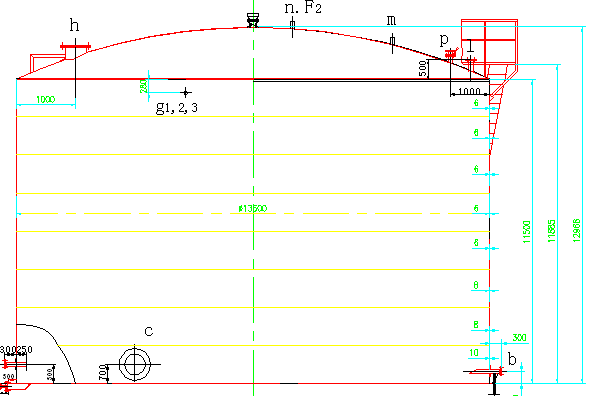Design and installation of large vertical oil tanks
Categories:
Hong Kong Qingshan Power Plant 7000m undertaken by our company ³ Wave pattern painting on the outer wall of process water tank is completed! Recently, our company undertook 7000 m of Hong Kong Qingshan Power Plant ³ The external wall of process water tank is painted with wavy pattern. The completion of this work also indicates that Hong Kong Qingshan Power Plant is 7000m ³ The process water tank construction and installation project has been formally completed and will be put into formal production.
The specifications used in the design of large oil tanks, from a global perspective, mainly include the American Petroleum Institute standard API650, the Japanese industrial standard JIS B8501, the British industrial standard BS2654, and the Chinese national standard GB50341. The formulas used in each specification are derived from the circumferential stress calculation formula in thin film theory. Combined with the stress characteristics of the oil tank, the allowable stress, weld coefficient, and wall thickness additional amount become the complete wall thickness calculation formula. Each specification determines its own allowable stress and weld coefficient based on the performance characteristics and construction technology level of their respective countries. Therefore, for oil tanks of the same volume, the calculation results of the tank wall thickness may vary greatly depending on different specifications.
Details
Design and Installation Specification for Large Vertical Oil Tanks in China
1、 Execution standards:
1. Domestic design standard: GB50341-2003 "Design Specification for Vertical Cylindrical Steel Welded Oil Tanks"
2. Domestic construction standard: GB 50128-2005 "Construction and Acceptance Specification for Vertical Cylindrical Steel Welded Oil Tanks"
2、 Design specifications:
1. The specifications used in the design of large oil tanks, from a global perspective, mainly include the American Petroleum Institute standard API650, the Japanese industrial standard JIS B8501, the British industrial standard BS2654, and the Chinese national standard GB50341. The formulas used in each specification are derived from the circumferential stress calculation formula in thin film theory. Combined with the stress characteristics of the oil tank, the allowable stress, weld coefficient, and wall thickness additional amount become the complete wall thickness calculation formula. Each specification determines its own allowable stress and weld coefficient based on the performance characteristics and construction technology level of their respective countries. Therefore, for oil tanks of the same volume, the calculation results of the tank wall thickness may vary greatly depending on different specifications.
2. The Chinese national standard GB50341-2003 specifies the allowable stress and weld seam coefficient based on the performance characteristics of domestic materials and the overall level of domestic construction enterprises, which is more in line with the national situation. Therefore, this standard is basically adopted in the design of oil tanks in our country.
3、 Construction specifications:
1. Construction method: The basic method for constructing ordinary vertical storage tanks is to use the guide chain inversion method: construction preparation → material inspection → cutting → processing → inspection → welding of the middle plate at the tank bottom → welding of the arched edge plate at the tank bottom → installation of the central column and umbrella frame → welding of the top ring → welding of the edge steel → assembly of the temporary arch support → assembly of the guide chain lifting device → welding of the arch top → welding of the lower ring → lifting of the top ring wall plate → welding of the circumferential seam → welding of the circumferential seam of each circle → welding of the bottom plate corner seam of the bottom ring → edge plate of the bottom plate → inspection → installation of accessories → vacuum test → overall test → settlement observation → handover.
2. Tank body prefabrication: 3 arc-shaped templates: 1 template for checking the curvature of the arch, with a chord length of no less than 2 meters; Check one inner arc template with a chord length of no less than 1 meter for deformation at the corner of the vertical weld seam; Check one outer arc template for deformation of the vertical weld seam, with a chord length of no less than 1 meter.
3. Tank body assembly: According to the order of tank installation, the lower surface of the bottom plate should be anti-corrosion before installation. Before laying the bottom plate, the surface should be marked with a vertical and horizontal cross centerline on the basis of acceptance. When the deviation of the centerline marked by the civil engineering is large (but within the allowable range), it should be adjusted to the minimum.
4. Tank welding and weld inspection: The welding process evaluation of butt joints, T-shaped corner welds, and tube plates should be carried out in accordance with JB4708-92 "Welding Process Evaluation of Steel Pressure Vessels". The on-site welding process guide book should be prepared. Personnel responsible for non-destructive testing of tank welds should undergo radiographic testing in accordance with GB3323-87 "Radiography and Quality Classification of Steel Melt Welding Butt Joints".
4、 Detection method:
1. Tank body test: Bottom plate vacuum leakage test, using vacuum method to test the leakage of all bottom plate welds, the vacuum degree should not be less than 53Kpa, and retesting should be carried out using penetration testing method.
2. Tank filling test: Floating disc lifting test, foundation settlement observation. Then temporarily seal the openings in the upper part, open the transparent holes on the top of the tank, and fill the tank with water. The test water should be fresh water, and the water temperature should not be lower than 5 degrees Celsius. Keep it stable for 48 hours.
3. Tightness test, strength test and stability test of tank wall and top: when filling the tank with water, when the water level is higher than 1m, close the transparent hole on the tank top and the air vent of foam mouth, continue to fill the tank with water, and observe the pressure reading by setting a temporary pressure gauge on the tank top. The stability test is carried out after the water filling test. When the water reaches the highest operating liquid level, all openings should be closed and the water should be discharged slowly. Negative pressure is generated in the tank, and the negative pressure reading should be closely monitored. When the negative pressure reading reaches 200mm water column, the water should be stopped and immediately filled into the tank to restore normal pressure.
4. Ultrasonic testing: Perform penetration testing or magnetic particle testing on the corner welds of the tank body and the reinforcement plate.
Product example diagram

Code for design and installation of large vertical oil tanks in China
1、 Executive standard:
1. Domestic design standard: GB50341-2003 Code for Design of Vertical Cylindrical Steel Welded Oil Tanks
2. Domestic construction standard: Code for Construction and Acceptance of Vertical Cylindrical Steel Welded Oil Tanks (GB 50128-2005)
2、 Design specification:
1. The codes used for the design of large oil tanks are mainly API 650, JIS B8501, British Industrial Standard BS2654 and Chinese National Standard GB50341 from a worldwide perspective. The formulas used in each code are derived from the formula for calculating the circumferential stress in the membrane theory. Combined with the stress characteristics of oil tanks, the allowable stress, weld joint coefficient and additional wall thickness become a complete wall thickness calculation formula, Each specification determines its own allowable stress and weld coefficient according to the performance characteristics of materials and construction technology level of its own country. Therefore, oil tanks of the same volume are calculated according to different specifications, and the calculation results of tank wall thickness sometimes vary greatly.
2. According to the performance characteristics of domestic materials and the allowable stress and weld joint coefficient specified by the overall level of domestic construction enterprises, the Chinese national standard GB50341-2003 is more in line with the national conditions. This code is basically adopted in the design of oil tanks in our country.
3、 Construction specifications:
1. Construction method: the construction of ordinary vertical storage tank basically adopts the chain inversion method: construction preparation → material inspection → blanking → processing → inspection → welding of tank bottom middle plate → bow edge plate of tank bottom → center column Erection of umbrella frame → assembly and welding of top ring → assembly and welding of wrapped angle steel → assembly of temporary vault support → guide chain lifting device → assembly and welding of vault → assembly and welding of lower ring → jacking of top ring wall plate → circumferential seam welding → assembly and welding of each circumferential seam → assembly and welding of bottom ring bottom plate corner seam → bottom plate edge plate → inspection → accessory installation → vacuum test → overall test → settlement observation → handover.
2. Tank body prefabrication: three arc templates: one template for checking the curvature of the vault, with chord length not less than 2m; Check one inner arc sample plate with chord length not less than 1m for deformation of vertical weld corner; Check one outer arc sample plate for vertical weld deformation, and its chord length shall not be less than 1m.
3. Tank body assembly: according to the tank installation sequence, the lower surface of the bottom plate shall be protected against corrosion before installation. Before laying the base plate, the vertical and horizontal cross center lines shall be drawn on the surface on the basis of qualified acceptance. When the center line deviation marked by civil engineering is large (but within the allowable range), it shall be adjusted to the minimum.
4. Tank welding and weld inspection: the welding process assessment of butt joints, T-shaped fillet welds and tubesheet shall be carried out according to JB4708-92 Welding Process Assessment of Steel Pressure Vessels, and the on-site welding process instructions shall be prepared. The radiographic inspection of tank welds shall be carried out according to GB3323-87 Radiography and Quality Grading of Butt Joints of Fusion Welding of Steel.
4、 Test method:
1. Tank body test: vacuum leak test for the bottom plate. The vacuum method shall be used to test the leak of all the bottom plate welds. The vacuum degree shall not be less than 53Kpa, and the penetrant flaw detection method shall be used for reinspection.
2. Water filling test of tank body: floating plate lifting test, foundation settlement observation. Then, temporarily close all the openings on the upper part, open the transparent holes on the tank top, and fill the tank with water. The test water shall be fresh water, the water temperature shall not be lower than 5 ℃, and the pressure shall be maintained for 48 hours.
3. Tightness test, strength test and stability test of the tank wall and top: when filling the tank with water, when the water level is higher than 1m, close the transparent hole and foam vent on the tank top, continue to fill the tank with water, and set a temporary pressure gauge on the tank top to observe the pressure reading. The pressure stabilization test shall be carried out after the water filling test. When the water filling reaches the maximum operating liquid level, all openings shall be closed, and the drainage shall be carried out slowly. The negative pressure in the tank shall be generated, and the negative pressure reading
Keyword:
Floating roof oil tank
General contracting of petrochemical construction
General contracting of construction engineering
General contracting of electromechanical engineering construction
General contracting of penstock construction
Inquiry
Contact
Headquarter address: Floor 8, Shui'an International Office Building, Sanjiao Road, Heping Avenue, Wuchang District, Wuhan, Hubei Province
Factory address: Shuangliu Gulong Economic Development Zone, Yangluo District, Wuhan
Follow us


Quick navigation

